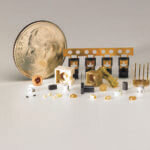- Schaeffler has supplied a custom direct drive motor solution for a giant reflecting telescope in The Canary Islands
- The drive solution from Schaeffler ensures the precise positioning of the telescopic camera and regulates its speed
- The compact, segmented design of the motor cut transportation and mounting costs, while optimising system performance and maintenance
Schaeffler has provided a rotating direct drive motor solution to a giant telescope located on La Palma in the Canary Islands – one of the world’s largest reflecting telescopes.
Astronomers and astrophysicists researching outer space rely on high performance telescopes to closely observe galaxies far away. When looking to the stars and exploring planets, black holes and other distant celestial bodies, the first thing to do is find a high vantage point. Nowhere else in Europe is the night sky so dark and clear as it is when viewed from the Roque de los Muchachos ridge on La Palma, which rises to a height of almost 2,500 metres. This offers professional stargazers ideal research conditions thanks to the Atlantic island’s extremely low levels of light pollution.
This remote location is home to a dozen different observatories and therefore offers astronomers from numerous different countries an infrastructure found almost nowhere else in the world. Of all the observatories located on the Roque de los Muchachos ridge, the Gran Telescopio de Canarias (GTC) stands out the most. With its 36 reflectors and a diameter of 10.4 metres, the silver-coloured steel structure is one of the world’s largest reflecting telescopes. The GTC, which was opened in 2009 at a cost of 80 million euros, weighs around 300 tonnes and has already spotted more than 2,000 planets and discovered galaxies far away.
High precision movements
Giant telescopes such as the GTC operate with extremely high precision. Scientists observing the stars at night or in the early hours of the morning, rely on long exposure times, which means the telescope must be able to move with millimetre precision – an immensely challenging task given the enormous weight involved.
Schaeffler has already proved its expertise in this sector in 2015 when the company supplied a torque motor for a satellite observation station in Changchun, China, which is part of the National Astronomical Observatories belonging to the Chinese Academy of Sciences.
Expertise from the Industrial Drives division
Schaeffler Iberia contributed its specialist engineering expertise in industrial drives to this latest project on La Palma and was involved in developing an instrument rotator for one of the GTC’s focal stations, known as the Cassegrain Focal Station (CG-Set). IDOM, a Spanish company that provides engineering and architecture services, was commissioned to develop this new CG set. Due to a positive experience during its long-standing collaboration with Schaeffler Iberia in various projects, IDOM decided to involve Schaeffler in the development of the instrument rotator drive.
The instrument rotator is an important high precision mechanism in the telescope and controls the focal tracking and rapid positioning system that rotates the two-tonne telescopic camera with outstanding eveness throughout the entire observation in order to ensure its perfect alignment with the heavens from start to finish. In this specific case, Schaeffler’s special drive solution not only had to ensure the system’s ability to precisely position the camera and regulate its speed, but also had to feature a compact, lightweight instrument rotator.
Benefits of the Schaeffler solution
Schaeffler devised a special solution that optimally suited the application requirements. A segmented, slotless RMF torque motor was developed for the drive of the instrument rotator. Assistance was also provided by Schaeffler during the mounting process in order to determine the motor’s control parameters. The direct drive from Schaeffler Industrial Drives is characterised by its highly dynamic yet very even motion, which also takes place with a high level of energy efficiency. The special motor, which is more than two metres in diameter, was developed and built based on a proven drive concept from machine tools for grinding operations that was adapted for the telescope.
This innovative solution also has other advantages. The segmented design of the motor reduced the costs of transportation and mounting. Furthermore, the relatively compact design facilitated the installation process and also helps to optimise the overall system’s performance and maintenance. A particularly important advantage is that only the affected segment – rather than the entire motor – must be replaced when servicing is required.
“This telescopic project impressively demonstrates Schaeffler’s extensive technological expertise and innovative capabilities. With our unconventional drive solution, we have successfully created a special application that will allow mankind to accurately explore space and thus support groundbreaking international research. At the same time, our product provides a convincing level of added value for the customer when it comes to the performance, energy consumption and future maintenance of the system,“ explains Albert Monera-Llorca, President of the Industrial division for Schaeffler Spain and Southern Europe.
For more information, please contact Schaeffler UK’s Communications & Branding Department on [email protected]
- The drive solution from Schaeffler is a segmented, slotless RMF torque motor.
- The RMF torque motor consists of segments, which reduced the costs of transportation and mounting.







